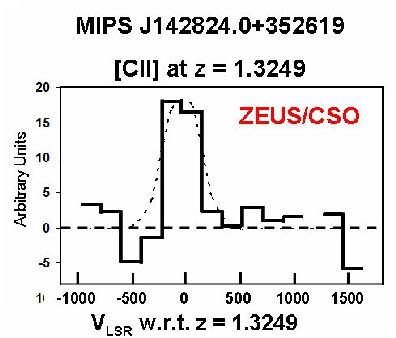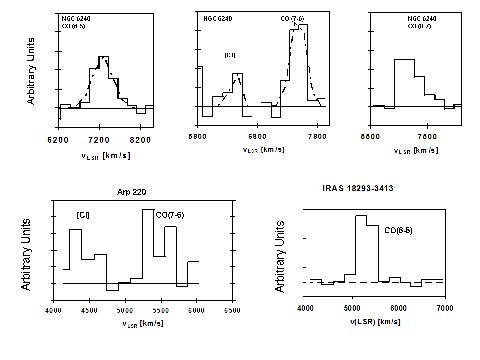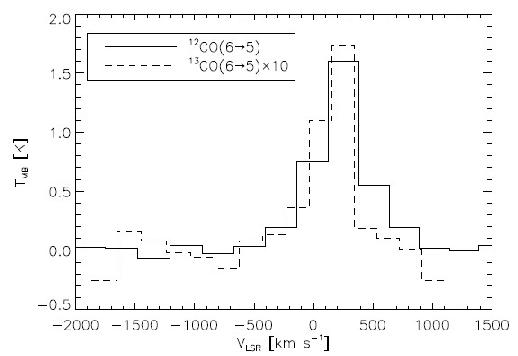
 The
Redshift(Z) and Early Universe Spectrometer, ZEUS, on the CSO: Probing
Star Forming Regions over the History of the Universe
The
Redshift(Z) and Early Universe Spectrometer, ZEUS, on the CSO: Probing
Star Forming Regions over the History of the Universe

How do the star forming
regions in galaxies in the local Universe differ from those in the
distant past?
How is the star formation rate affected by the environment in these
galaxies and does a starburst in a
galaxy propagate itself, or is it self-limiting? These are
important questions that the instrument called
"the redshift (Z) and Early Universe Spectrometer" (ZEUS) was
designed to investigate. ZEUS is a grating
spectrometer that operates in the 650 - 850 GHz range (350 - 460
micron). It was developed by a group at
Cornell University, led by Professor Gordon Stacey.
Star formation occurs in the cores of dusty clouds where most of
the light from the newly formed stars is
absorbed by dust and re-radiated in the far-infrared. At
redshifts great than 1, most of this far-IR radiation
is redshifted into the short submillimeter bands so that observations
in the submillimeter telluric windows are
key to understanding the starformation processes in the early Universe.
Prof. Stacey's group at Cornell
University has built the grating spectrometer, ZEUS, that operates in
this wavelength regime and that is
specifically designed to investigate the physical properties of the gas
in regions of enhanced star format
ion in galaxies in the local Universe and the early Universe. With the
instrument ZEUS, they observe
mid-J CO lines, the [CI] 371 micron fine structure line, and redshifted
far-infrared fine structure lines,
especially the 158 micron [CII] line to trace the gas properties in the
star forming regions.
Their observations show large amounts of warm and dense
molecular gas in Ultra-Luminous Infrared Galaxies
(ULIRGs) in the local Universe with temperatures greater than 100 K and
densities in the range of 104 cm-3 to 105
cm-3.
This elevated temperature in the bulk of molecular clouds also suggests
that the continuation of enhanced star
formation is inhibited, since the elevated temperature in the molecular
cloud increases the internal pressure and thus
provides additional support against cloud collapse. In the case
of the starburst galaxy NGC 253 (see Fig 3), vast
amounts of cosmic rays from supernovae may be the main heating source
of the
warm molecular gas. The starburst
regions in the ULIRGs in the local Universe (the current epoch) are
very compact with
sizes less than a few 100 parsec.
In contrast to the compactness of the starbursts in the local Universe,
their observations
of the [CII] line from ULIRGs
at high redshift indicate that the starbursts in those ULIRGs is very
extended with sizes of
several kiloparsecs. This
suggests that the starburst in ULIRGs at high redshift is
galaxy-wide. The trigger mechanism
that causes the starbursts
in the local Universe and the much more massive starbursts in the early
Universe, is most likely
collisions between
galaxies. However, as their observations indicate, this trigger
mechanism affects the galaxies very differently, leading
to extended starburst in the early Universe and compact starburst in
the local Universe.

Figure 1. [CII]
spectrum taken towards one of the high-redshifted galaxies with ZEUS.

Figure 2. Spectra in submillimeter
wavelength range taken towards high redshifted galaxies

Figure 3. J=6-5 Spectra of CO & the isotope 13CO
of the galaxy NGC 253
Detailed document about this result
(PDF file, 196kB)
Go back to A Digest of Recent News and
Scientific Results at the Caltech Submillimeter Observatory

 The
Redshift(Z) and Early Universe Spectrometer, ZEUS, on the CSO: Probing
Star Forming Regions over the History of the Universe
The
Redshift(Z) and Early Universe Spectrometer, ZEUS, on the CSO: Probing
Star Forming Regions over the History of the Universe 

 The
Redshift(Z) and Early Universe Spectrometer, ZEUS, on the CSO: Probing
Star Forming Regions over the History of the Universe
The
Redshift(Z) and Early Universe Spectrometer, ZEUS, on the CSO: Probing
Star Forming Regions over the History of the Universe 


